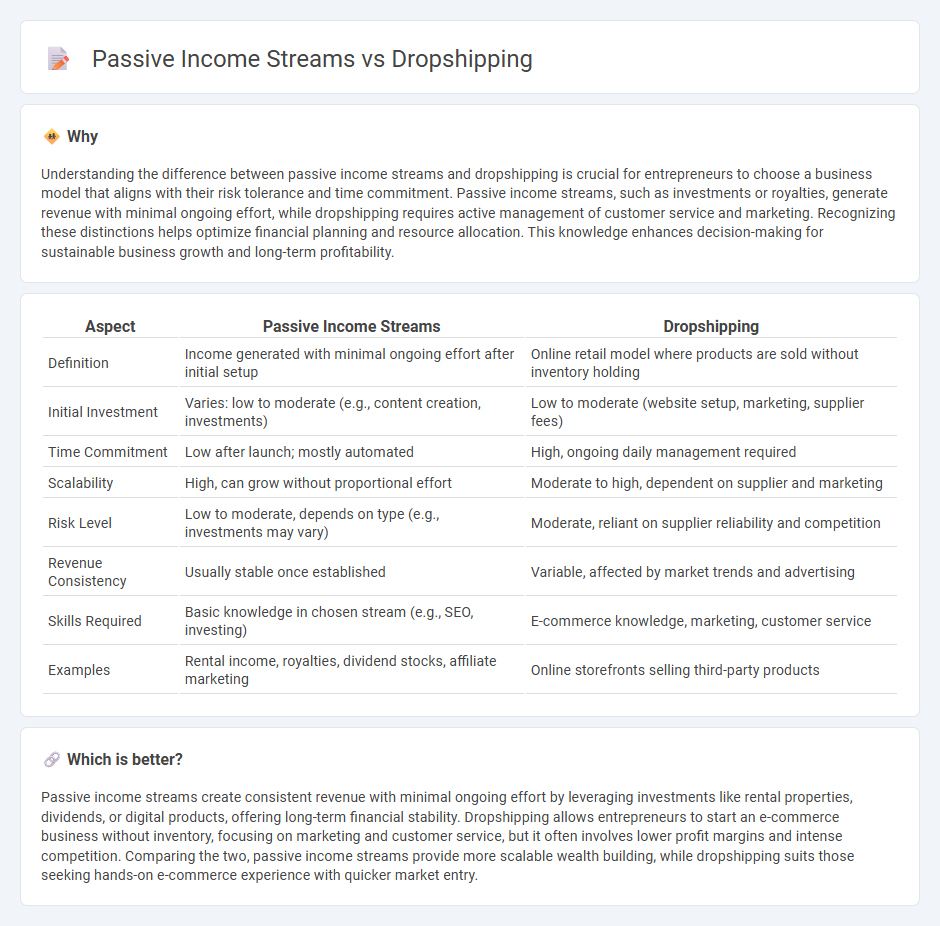
Passive income streams generate continuous revenue with minimal ongoing effort by leveraging investments like rental properties, dividends, or digital products. Dropshipping involves selling products online without holding inventory, acting as a middleman between suppliers and customers to earn profit margins. Explore the advantages and challenges of both models to determine the best fit for your entrepreneurial goals.
Why it is important
Understanding the difference between passive income streams and dropshipping is crucial for entrepreneurs to choose a business model that aligns with their risk tolerance and time commitment. Passive income streams, such as investments or royalties, generate revenue with minimal ongoing effort, while dropshipping requires active management of customer service and marketing. Recognizing these distinctions helps optimize financial planning and resource allocation. This knowledge enhances decision-making for sustainable business growth and long-term profitability.
Comparison Table
| Aspect | Passive Income Streams | Dropshipping |
|---|---|---|
| Definition | Income generated with minimal ongoing effort after initial setup | Online retail model where products are sold without inventory holding |
| Initial Investment | Varies: low to moderate (e.g., content creation, investments) | Low to moderate (website setup, marketing, supplier fees) |
| Time Commitment | Low after launch; mostly automated | High, ongoing daily management required |
| Scalability | High, can grow without proportional effort | Moderate to high, dependent on supplier and marketing |
| Risk Level | Low to moderate, depends on type (e.g., investments may vary) | Moderate, reliant on supplier reliability and competition |
| Revenue Consistency | Usually stable once established | Variable, affected by market trends and advertising |
| Skills Required | Basic knowledge in chosen stream (e.g., SEO, investing) | E-commerce knowledge, marketing, customer service |
| Examples | Rental income, royalties, dividend stocks, affiliate marketing | Online storefronts selling third-party products |
Which is better?
Passive income streams create consistent revenue with minimal ongoing effort by leveraging investments like rental properties, dividends, or digital products, offering long-term financial stability. Dropshipping allows entrepreneurs to start an e-commerce business without inventory, focusing on marketing and customer service, but it often involves lower profit margins and intense competition. Comparing the two, passive income streams provide more scalable wealth building, while dropshipping suits those seeking hands-on e-commerce experience with quicker market entry.
Connection
Passive income streams and dropshipping are closely connected as dropshipping provides an accessible business model that generates revenue without the need for inventory management or upfront stock investments. Entrepreneurs leverage dropshipping to create automated sales funnels, enabling passive income through online stores that fulfill orders directly from suppliers. This synergy allows for scalability and reduced risk while maintaining consistent cash flow, essential components for sustainable entrepreneurship.
Key Terms
Inventory Management
Dropshipping eliminates the need for inventory management by allowing sellers to forward orders directly to suppliers, reducing overhead and storage costs. Passive income streams, such as royalties or digital products, require minimal ongoing inventory concerns but may involve initial content creation or product development. Explore how managing inventory impacts different income strategies to optimize your revenue potential.
Automation
Dropshipping leverages automation tools such as inventory management software and order processing systems to minimize manual effort, enabling scalable e-commerce with reduced hands-on involvement. Passive income streams often involve automated investments, royalty collections, or digital product sales, where technology handles routine transactions and customer interactions seamlessly. Discover more about optimizing automation in various income models to boost efficiency and profitability.
Profit Margins
Dropshipping typically offers slimmer profit margins, often ranging from 10% to 30%, due to product sourcing and shipping costs handled by third parties. Passive income streams such as rental properties, dividend stocks, or digital products can yield higher margins, frequently exceeding 50%, because of lower ongoing expenses after initial investment. Explore detailed strategies to maximize profit margins in both dropshipping and other passive income sources.
Source and External Links
What Is Dropshipping and How Does It Work? (2025) - Shopify - Dropshipping is a business model where a store sells products it doesn't keep in stock; when a customer orders, the supplier ships the product directly to them, allowing the retailer to avoid inventory management and shipping logistics.
What Is Dropshipping and How Does It Work? - Wix.com - Dropshipping is a retail fulfillment method in which the seller creates an online store, sells products from suppliers without holding inventory, and relies on suppliers to store, package, and ship the products directly to customers.
Drop shipping - Wikipedia - Drop shipping is a supply chain management method where a retailer accepts orders but transfers order and shipment details to suppliers who ship directly to customers, minimizing the retailer's costs and inventory risks but reducing control over quality and shipping.
 dowidth.com
dowidth.com